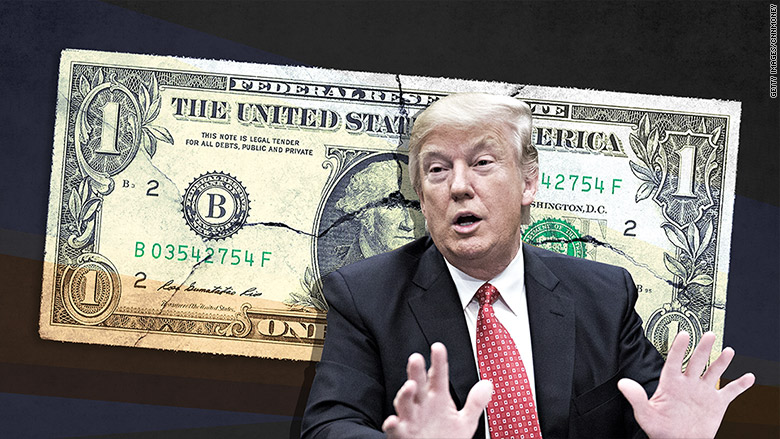Canadian Dollar Gains Momentum: Trump's Influence On Currency Markets

Table of Contents
Trump's Trade Wars and Their Effect on the Canadian Dollar
Trump's administration initiated a period of significant trade uncertainty, profoundly affecting the Canadian dollar. His approach to international trade created ripples across global markets, with the Canadian economy and its currency being particularly susceptible.
NAFTA Renegotiations and Uncertainty
The renegotiation of the North American Free Trade Agreement (NAFTA), renamed the USMCA, under Trump's administration injected considerable uncertainty into the Canadian economy. This period of negotiation created considerable volatility in the Canadian dollar. Investors, hesitant about the future of trade between Canada, the US, and Mexico, reacted by either reducing their holdings of the Canadian dollar or hedging their investments. This uncertainty directly contributed to fluctuations in the CAD/USD exchange rate.
- Increased volatility: The CAD/USD experienced heightened volatility throughout the renegotiation process.
- Short-term declines: Periods of negative news regarding NAFTA negotiations resulted in short-term depreciations of the Canadian dollar.
- Long-term resilience: Despite the uncertainty, the Canadian dollar ultimately showed resilience, reflecting the underlying strength of the Canadian economy. Data from this period shows a clear correlation between negative headlines and short-term dips, but a generally stable long-term trend once the USMCA was ratified.
Tariffs and Retaliatory Measures
Trump's imposition of tariffs on Canadian goods, particularly steel and aluminum, sparked retaliatory measures from Canada. These trade disputes directly impacted specific Canadian sectors, leading to economic slowdowns and influencing the value of the Canadian dollar. The resulting trade friction negatively impacted investor sentiment, further contributing to CAD/USD exchange rate fluctuations.
- Impact on specific sectors: Industries like steel and aluminum experienced significant disruptions due to tariffs.
- Shift in trade patterns: Canadian businesses adapted by diversifying their export markets, seeking alternative trading partners outside the US.
- Investor response: Uncertainty surrounding trade relations led to reduced foreign direct investment in Canada, impacting the Canadian dollar's value.
Trump's Monetary Policy Influence on the USD and CAD Exchange Rate
The US Federal Reserve's monetary policy under Trump also played a crucial role in shaping the USD/CAD exchange rate. Interest rate adjustments and the overall strength of the US dollar had a direct impact on the Canadian dollar.
Impact of US Interest Rate Changes
Changes in US interest rates directly influenced the USD/CAD exchange rate. Higher interest rates in the US attracted capital inflows, increasing demand for the US dollar and consequently putting downward pressure on the Canadian dollar. Conversely, lower interest rates in the US had the opposite effect.
- Interest rate hikes and CAD appreciation: Periods of US interest rate hikes often coincided with a strengthening US dollar and a weakening Canadian dollar.
- Interest rate cuts and CAD depreciation: Reductions in US interest rates generally had the opposite effect, strengthening the Canadian dollar.
The Dollar's Overall Strength and Weakness
The overall strength or weakness of the US dollar under Trump’s presidency significantly impacted the Canadian dollar. The two currencies often exhibit an inverse relationship; a strong USD typically leads to a weaker CAD, and vice-versa.
- Safe haven status of the USD: During times of global uncertainty, investors often flock to the US dollar as a safe haven, weakening the Canadian dollar.
- Global economic conditions: Global economic downturns or geopolitical instability can impact both currencies, but their relationship is often inverse.
- Flight to safety trends: Periods of heightened risk aversion often lead to increased demand for the US dollar, negatively impacting the Canadian dollar.
Geopolitical Factors and Trump's Role
Trump's unpredictable foreign policy added another layer of complexity to the CAD/USD dynamics. His actions created global market uncertainty, influencing the Canadian dollar's performance as a safe-haven currency during turbulent times.
Trump's Foreign Policy and its Spillover Effects
Trump's foreign policy decisions, often characterized by unpredictability, impacted global market sentiment. This uncertainty, in turn, affected the Canadian dollar's value, sometimes causing it to appreciate as investors sought safer investments.
- Trade agreements with other countries: Trump's renegotiation of existing trade agreements and pursuit of new ones created uncertainty across global markets.
- International relations: Trump's often strained relationships with international allies contributed to heightened global uncertainty.
- Investor confidence: The overall impact on investor confidence was a significant factor in how the Canadian dollar performed.
Increased Volatility in the Global Markets
Trump's actions frequently contributed to increased volatility in global financial markets. This volatility impacted the Canadian dollar, which is sensitive to shifts in global investor sentiment.
- Market uncertainty: The unpredictable nature of Trump's policies resulted in higher market uncertainty.
- Risk aversion: Periods of heightened risk aversion often led to increased demand for safe-haven assets, potentially impacting the Canadian dollar.
- Safe haven demand: The Canadian dollar, while not a primary safe-haven currency like the US dollar or the Japanese yen, can experience increased demand during periods of heightened global uncertainty.
Conclusion
The Canadian dollar's recent performance is deeply intertwined with the policies and actions of former US President Donald Trump. His trade wars, fluctuating monetary policies, and unpredictable foreign policy all significantly impacted the CAD's trajectory. Understanding these complex relationships is vital for navigating the foreign exchange market effectively.
Call to Action: Stay informed about the latest developments affecting the Canadian dollar and global markets. Monitor key economic indicators and policy changes to make informed decisions regarding your investments in the Canadian dollar and other currencies. Develop a comprehensive understanding of the factors that influence the Canadian dollar's value to effectively manage your financial portfolio.

Featured Posts
-
 127 Years Of Brewing History Ends Anchor Brewing Company Shuts Down
May 03, 2025
127 Years Of Brewing History Ends Anchor Brewing Company Shuts Down
May 03, 2025 -
 Is Reform Uk Doomed Five Warning Signs For Farages Party
May 03, 2025
Is Reform Uk Doomed Five Warning Signs For Farages Party
May 03, 2025 -
 The Fallout From The Justice Departments School Desegregation Order Termination
May 03, 2025
The Fallout From The Justice Departments School Desegregation Order Termination
May 03, 2025 -
 Sony Unveils New Play Station Beta Program Features And Participation
May 03, 2025
Sony Unveils New Play Station Beta Program Features And Participation
May 03, 2025 -
 Leaked Fortnite Icon Skin Images And Speculation
May 03, 2025
Leaked Fortnite Icon Skin Images And Speculation
May 03, 2025
